Customers who contact a company receive an experience, whether in person, on a website, in a tailored email, or via an app notification. Consider an experience a collection of material and assets, including photos, videos, text, buttons, forms, or headlines.
When customers contact a company, they have a specific objective: to buy something, learn more, or address a query. The perfect experience may persuade a consumer simply by delivering the material and messaging they seek.
Experiences shape a customer’s initial perception of a brand. They should be relevant, timely, and tailored to help consumers reach their desired outcome. However, today’s experiences frequently mismatch client expectations and wants, completely missing the target—and a conversion chance.
In this blog, we will examine the different aspects of Adobe Experience Manager Services, especially the transition from content to experience. Let’s get started.
What is Adobe Experience Manager (AEM)?
AEM (Adobe Experience Manager) is a complete content management tool that enables organizations to design, manage, and deliver customized digital experiences. It is a key component of the Adobe Experience Cloud, helping businesses provide rich and engaging content across platforms while offering analytics, marketing, and automation capabilities.
Why AEM to Improve Business Experience?
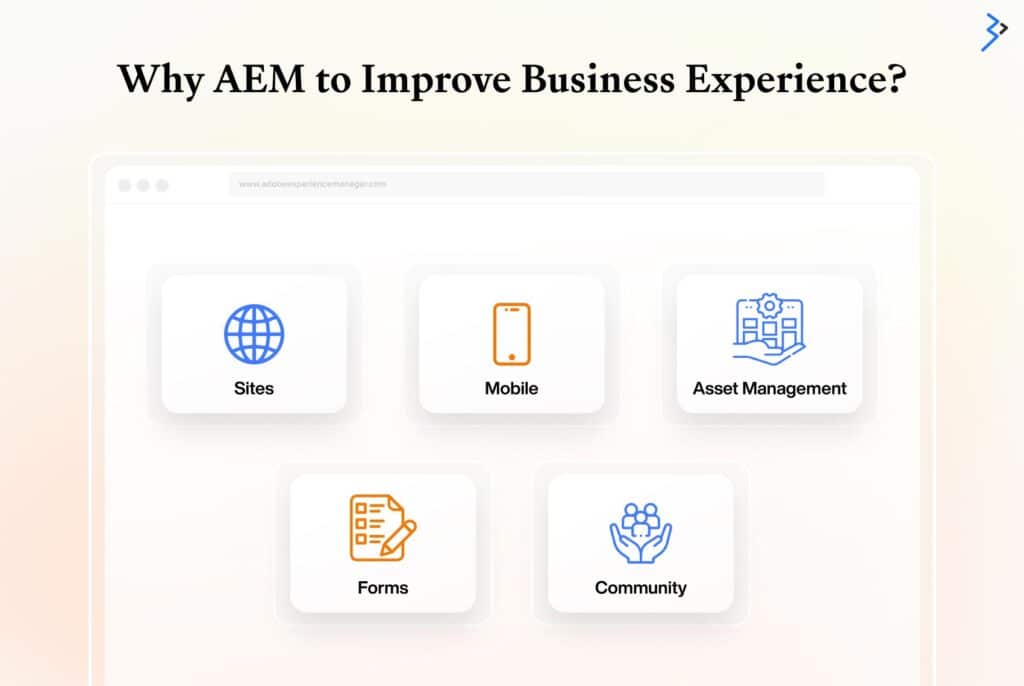
- Sites: Adobe AEM enables you to create responsive and intuitive websites in several languages and manage them from a single, centralized place. It also allows you to manage e-commerce or affiliate websites, B2B or B2C, easily.
- Mobile: AEM also provides organizations the functionality they need to create intuitive websites that work equally well on several platforms, such as Windows, Android, and iOS. With analytics and a user-friendly dashboard, businesses can simply examine and adjust the data on their apps.
- Asset Management: The platform enables you to generate unique variants of any assets created using Adobe’s Creative Cloud and effortlessly link them with the other modules to provide a unified experience.
- Forms: The platform also allows you to construct forms to collect essential data and provide a tailored experience for your consumers across all platforms. This significantly improves your brand’s image and awareness in a competitive marketplace.
- Community: AEM also enables you to communicate with your consumers in various ways on a single platform, allowing you to collect critical feedback, answer questions, and more.

The Inefficiencies of Today’s Content Supply Chains
The sheer volume of information required, from social media marketing and blog posts to videos and landing sites, might be intimidating. Brands invest extensively in developing thousands of assets to send across channels. Still, marketing teams struggle to turn that material into relevant, tailored experiences for different personas, geographies, and channels without the correct context and consumer data. It may be a time-consuming and resource-intensive job, resulting in an inefficient content supply chain.
The problem — slow, complex processes.
Content adaptation for different channels, geographies, and audiences is complex. Teams frequently spend significant time looking for the proper material, modifying it for certain circumstances, and ensuring it is consistent with the brand’s voice and regulatory requirements. This procedure is resource-intensive and lengthy due to the many factors, including intent, geographies, personalities, and sub-brands.
Furthermore, the necessity for speed and agility in today’s marketing marketplace requires teams to create bespoke experiences faster than before. However, using traditional approaches, marketing teams are frequently filled with manual chores that consume time and diminish productivity.
How AEM is Transforming Digital Content Management
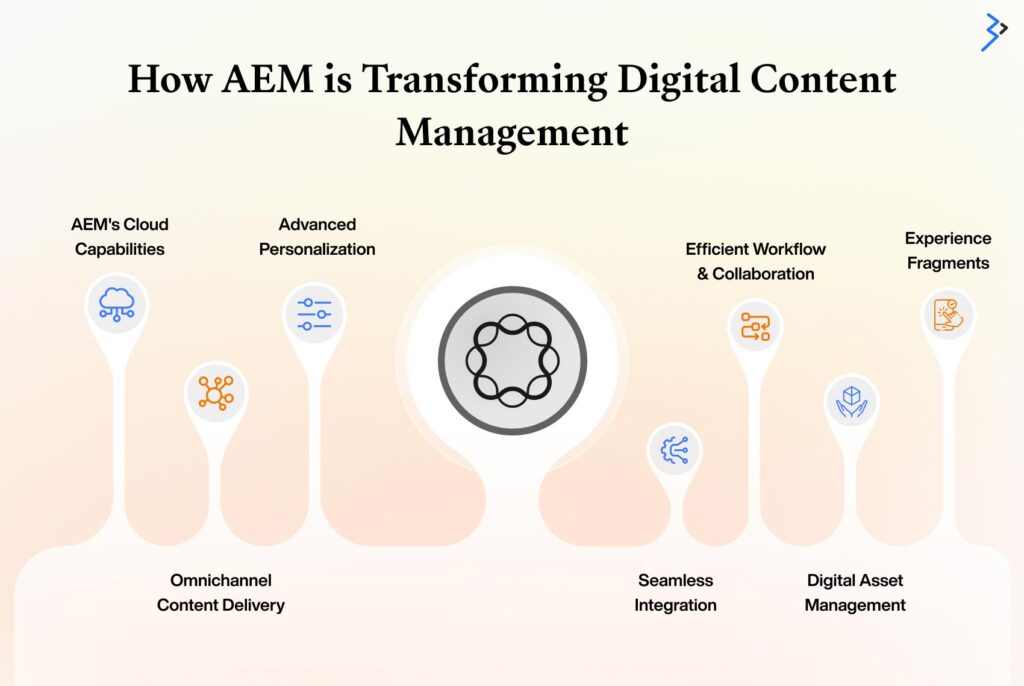
AEM overcomes the constraints of traditional CMS solutions by offering novel capabilities that simplify and improve digital content management.
AEM’s Cloud Capabilities
AEM’s cloud-native design enables scalability and worldwide delivery. It allows enterprises to grow their content operations effortlessly without worrying about infrastructure limits. The cloud’s capabilities also improve efficiency and availability, ensuring that information is delivered globally to users.
Omnichannel Content Delivery
AEM provides accurate omnichannel content delivery, allowing organizations to distribute consistent and seamless content across websites, mobile applications, social media, and IoT devices. This functionality ensures that consumers get a consistent experience no matter their channel, resulting in increased engagement and satisfaction.
Advanced Personalization
AEM uses Adobe Sensei, Adobe’s AI engine, to give intelligent, data-driven insights that improve customization. AEM automatically modifies content by evaluating user behavior and preferences to meet each visitor’s needs, providing tailored suggestions and experiences that increase conversions and engagement.
Seamless Integration
AEM seamlessly connects with other Adobe Experience Cloud solutions, including Adobe Analytics and Target, allowing organizations to fully utilize data-driven insights, personalization, and testing. This guarantees that each piece of content is optimized for performance and user engagement.
Efficient Workflow & Collaboration
AEM’s easy workflow management capabilities let teams collaborate more effectively. Thanks to built-in version control, task assignment, and approval processes, content producers, designers, and developers may collaborate effortlessly. Role-based access control guarantees that only the appropriate persons have the necessary permissions while ensuring security.
Digital Asset Management (DAM)
With AEM’s DAM features, organizations can manage all digital assets from one location. This enables teams to tag, store, and distribute media items like photographs and videos, maintaining brand consistency and accelerating content creation.
Experience Fragments
Experience Fragments enable organizations to develop reusable content components that can be used across channels. This saves time when developing fresh material and maintains consistency across several touchpoints.
AEM’s Role in Enhancing User Experience
AEM is meant to provide tailored, dynamic content that enhances the user experience. AEM enables organizations to personalize content to specific user requirements and preferences by combining real-time data from Adobe Analytics Services with AI-driven customization from Adobe Sensei.
Furthermore, AEM’s responsive design features guarantee that content is optimized for all platforms, giving consumers a consistent experience on a desktop, tablet, or mobile device.
Key Benefits of Using Adobe Experience Manager
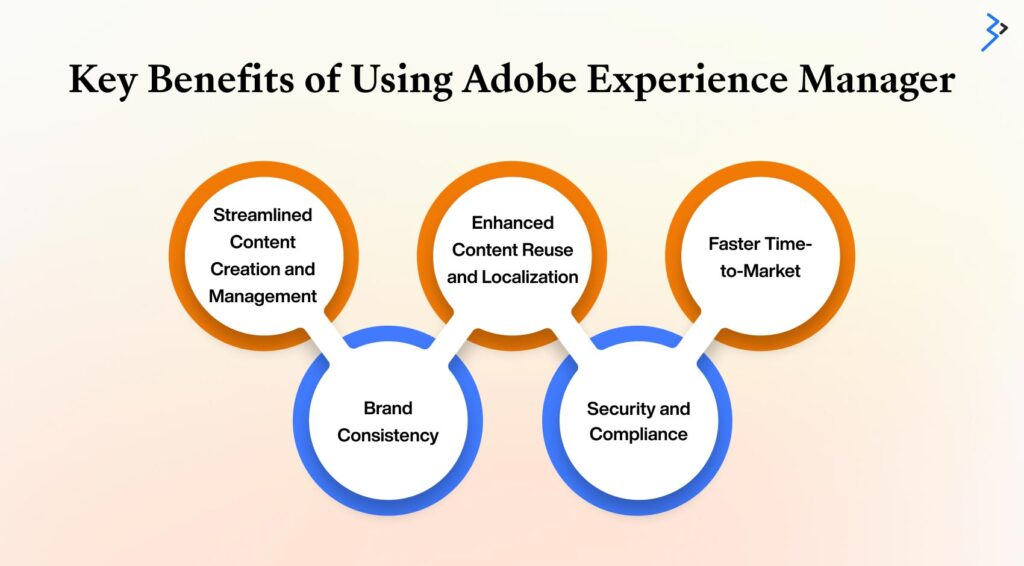
Businesses that adopt AEM for their digital content management experience several key benefits:
Streamlined Content Creation and Management:
AEM facilitates content writing, allowing for simple creation, editing, and publishing across numerous platforms from a central center.
Enhanced Content Reuse and Localization:
AEM’s Experience Fragments enable effective content reuse and localization for regional markets.
Faster Time-to-Market:
AEM’s automation and collaboration tools enable firms to accelerate content generation and launch campaigns faster.
Brand Consistency:
AEM protects brand integrity by ensuring consistent content across channels and locations.
Security and Compliance:
AEM provides extensive security features and compliance management to help enterprises satisfy regulatory standards.
Future Trends in AEM and Digital Content Management
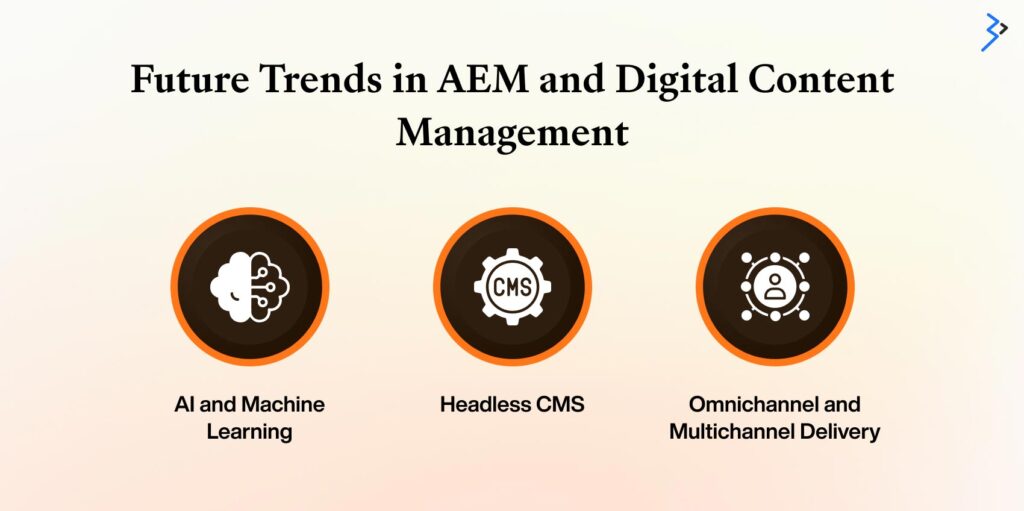
As digital content management evolves, AEM is well-positioned to keep up with changing trends:
- AI and Machine Learning: As AI and machine learning services technologies progress, AEM will provide more personalization and automation, allowing for more focused content experiences.
- Headless CMS: With AEM’s headless CMS features, enterprises can provide content via APIs to any platform, future-proofing content strategy for emerging technologies such as AR/VR and IoT
- Omnichannel and Multichannel Delivery: As digital touchpoints expand, AEM’s omnichannel delivery ensures that organizations can reach customers everywhere with consistent, tailored information.
Content and eCommerce with Adobe Experience Manager
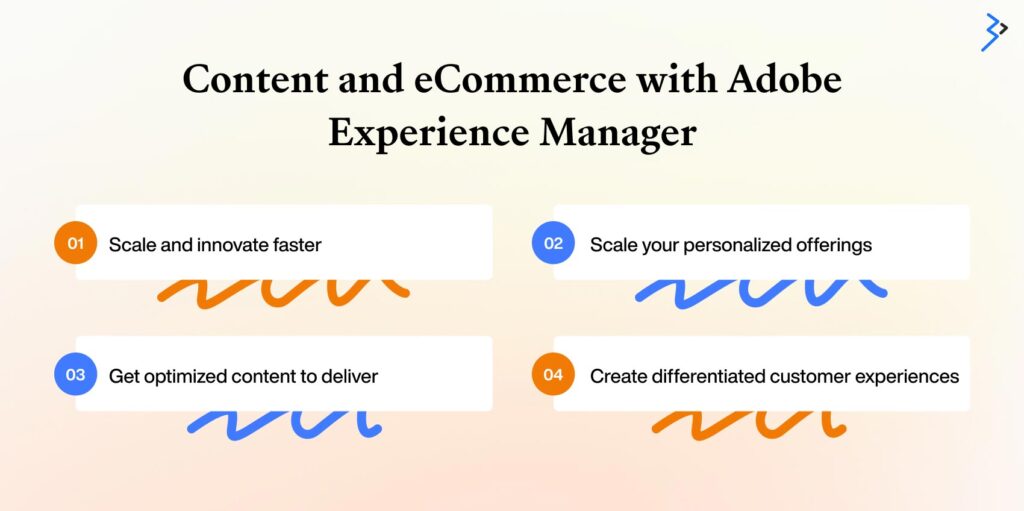
The technical requirements for achieving this Zen state vary depending on your use cases and digital transformation stage. These needs will also vary as your company matures digitally, so it is vital to have a technology stack that supports your digital transformation and your vision for the client experiences you want to provide.
The risk of using short-term solutions is that, as the firm becomes more digitally mature, it “outgrows” the solution, necessitating its replacement when its restrictions become too unpleasant. This is costly and significantly impacts restricted innovation since IT teams must constantly retool when a new solution is implemented.
Adobe Experience Manager as a Cloud Service is a premier content management system (CMS) that offers optimal assistance throughout your digital transition. It is designed to be transformational and can evolve alongside your company’s digital maturity. A diverse collection of continuous integration and delivery (CI/CD) ideas enables emerging channels and commercial prospects. For eCommerce and content, AEM’s Cloud Service provides a platform for fast expansion, allowing you to:
- Scale and innovate faster — Use an out-of-the-box link to any existing commerce engines to add shoppable experiences to every step of the customer’s journey, utilizing the most recent capabilities.
- Scale your personalized offerings — To build targeted promos and suggestions, track and collect user activity using the Commerce Integration Framework (CIF) extension’s pre-integrated data.
- Get optimized content to deliver – Create content and promotions that can be reused in traditional and new channels or devices.
- Create differentiated customer experiences — Using unified content and an eCommerce author, you can build dynamic media to set your e-commerce experiences apart.
Scale Faster, Better, & Efficiently With AEM Today
Generative AI enables faster, more efficient, and scalable content delivery. With this technology, marketing teams maintain control over transforming material into the customized and identifiable experiences that customers have grown to expect from your brand.
Even with generative AI development companies, marketing teams should always maintain control. So, change how you manage your operations with experts who understand the ins and outs of AEM.
Book a call with our experts today!
Related Articles
-
Streamlining Digital Asset Management with AEM Assets
Summary With 89% of marketers crediting personalization in their campaigns for positive ROI, it has become the key to success for many growing businesses. This is where organizations today are
-
How Retail Businesses Use AEM for eCommerce and Customer Engagement
Summary: It’s 2024; your online business needs more than a working website to stand among your competitors. Besides, your ideal clients won’t waste time around slow-loading websites to complete their
-
Optimizing Web Performance with Phased Rendering in Adobe Experience Manager
Web speed is critical to maintaining an excellent user experience, search engine rankings, and conversion rates. Phased rendering in Adobe Experience Manager (AEM) is a great way to improve online




